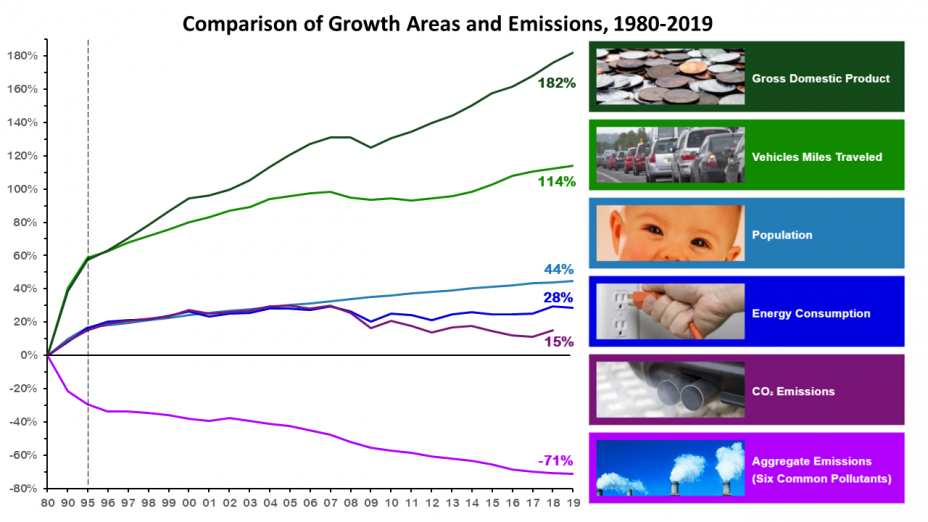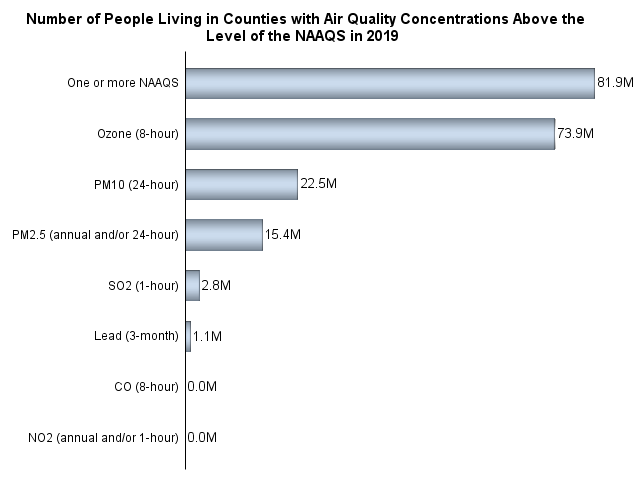Air Quality - National Summary
Air Quality Trends
EPA creates air quality trends using measurements from monitors located across the country. The table below show that air quality based on concentrations of the common pollutants has improved nationally since 1980.
| 1980 vs 2019 | 1990 vs 2019 | 2000 vs 2019 | 2010 vs 2019 | |
|---|---|---|---|---|
| Carbon Monoxide | -85 | -78 | -65 | -23 |
| Lead | -98 | -98 | -93 | -85 |
| Nitrogen Dioxide (annual) | -65 | -59 | -51 | -25 |
| Nitrogen Dioxide (1-hour) | -62 | -51 | -36 | -17 |
| Ozone (8-hour) | -35 | -25 | -21 | -10 |
| PM10 (24-hour) | --- | -46 | -46 | -17 |
| PM2.5 (annual) | --- | --- | -43 | -23 |
| PM2.5 (24-hour) | --- | --- | -44 | -21 |
| Sulfur Dioxide (1-hour) | -92 | -90 | -82 | -71 |
Emissions Trends
EPA estimates nationwide emissions of ambient air pollutants and the pollutants they are formed from (their precursors). These estimates are based on actual monitored readings or engineering calculations of the amounts and types of pollutants emitted by vehicles, factories, and other sources. Emission estimates are based on many factors, including levels of industrial activity, technological developments, fuel consumption, vehicle miles traveled, and other activities that cause air pollution.
Emissions information is developed with input from state and local air agencies, tribes, and industry. EPA tracks a range of emissions data, including how much of each pollutant is emitted from various pollution sources. To view national, state, and local emissions summary data, see EPA’s Air Emissions Sources site. The table below shows that emissions of the common air pollutants and their precursors have been reduced substantially since 1980.
| 1980 vs 2019 | 1990 vs 2019 | 2000 vs 2019 | 2010 vs 2019 | |
|---|---|---|---|---|
| Carbon Monoxide | -75 | -69 | -56 | -27 |
| Lead* | -99 | -87 | -76 | -30 |
| Nitrogen Oxides (NOx) | -68 | -65 | -61 | -41 |
| Volatile Organic Compounds (VOC) | -59 | -47 | -27 | -18 |
| Direct PM10 | -63 | -30 | -27 | -17 |
| Direct PM2.5 | --- | -36 | -43 | -20 |
| Sulfur Dioxide | -92 | -91 | -88 | -73 |
*As a result of the permanent phase-out of leaded gasoline, controls on emissions of lead compounds through EPA’s air toxics program, and other national and state regulations, airborne lead concentrations in the U.S. decreased 98 percent between 1980 and 2005. After 2005, the EPA methodology for lead changed and is not comparable to the 2005 and earlier numbers. Since 2008, emissions have continued to decrease by 30 percent from 2008 to 2017. In the 2017 NEI, the highest amounts of Pb emissions are from Piston Engine Aircrafts, and Ferrous and Non-ferrous Metals industrial sources. The 2008 and 2017 estimates were used to approximate the 2010 to 2019 percent change.
Emissions of air pollutants continue to play an important role in a number of air quality issues. In 2019, about 70 million tons of pollution were emitted into the atmosphere in the United States. These emissions mostly contribute to the formation of ozone and particles, the deposition of acids, and visibility impairment. To get detailed information about emissions estimates displayed below, please visit EPA's Air Pollutant Emissions Trends Data.
Annual emissions estimates are used as one indicator of the effectiveness of our programs. The graph below shows that between 1980 and 2019, gross domestic product increased 182 percent, vehicle miles traveled increased 114 percent, energy consumption increased 28 percent, and U.S. population grew by 44 percent. During the same time period, total emissions of the six principal air pollutants dropped by 71 percent. The graph also shows that between 1980 and 2018, CO2 emissions increased by 15 percent.
 Note: CO2 emissions estimate through 2018 (Source: US Greenhouse Gas Inventory Report)
Note: CO2 emissions estimate through 2018 (Source: US Greenhouse Gas Inventory Report)
Gross Domestic Product: Bureau of Economic Analysis
Vehicle Miles Traveled: Federal Highway Administration
Population: Census Bureau
Energy Consumption: Dept. of Energy, Energy Information Administration
Aggregate Emissions: EPA's Air Pollutant Emissions Trends DataSee this graph for 1970-2019

Despite great progress in air quality improvement, approximately 82 million people nationwide lived in counties with pollution levels above the primary NAAQS in 2019.
In addition, from 1990 to 2017 emissions of air toxics declined by 74 percent, largely driven by federal and state implementation of stationary and mobile source regulations.
In recent years, EPA has acted to dramatically improve America's air quality by designing and developing national programs that, when fully implemented, will achieve significant reductions in air emissions. The associated air quality benefits will lead to improved health, longevity, and quality of life for all Americans.
Weather Influence
Weather conditions influence emissions and air quality. EPA has developed statistical approaches to account for weather’s influence on ozone and fine particles. While these approaches do not change the quality of air we breathe, they do help us understand how well emission reduction programs are working. More information is available for trends in ozone adjusted for weather conditions.

